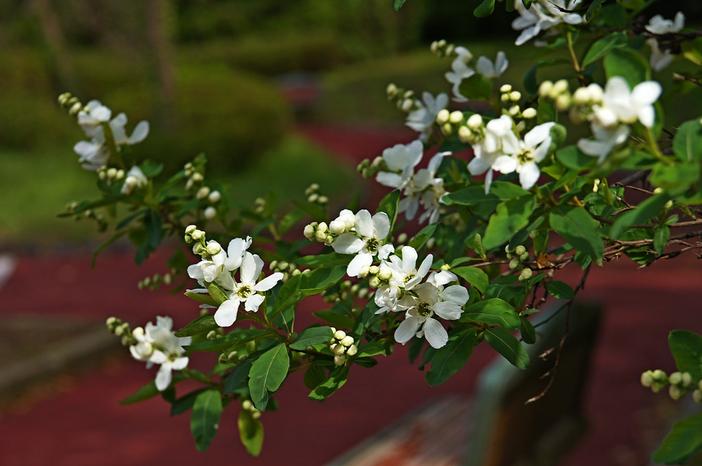Pearlbush
(Exochorda racemosa subsp. serratifolia)
Pearlbush (Exochorda racemosa subsp. serratifolia)
/
/

Tatters ✾
CC BY-SA 2.0
Image By:
Tatters ✾
Recorded By:
Copyright:
CC BY-SA 2.0
Copyright Notice:
Photo by: Tatters ✾ | License Type: CC BY-SA 2.0 | License URL: https://creativecommons.org/licenses/by-sa/2.0/ | Uploader: Tatters ✾ | Publisher: Flickr









Estimated Native Range
Summary
Exochorda racemosa subsp. serratifolia, commonly known as Pearlbush or Snow Day Surprise, is a deciduous shrub native to forest edges, slopes, and open woodlands in East Asia, including China and Korea. This shrub exhibits a moderate growth rate and typically reaches a height of 5-6 feet (1.5-1.8 meters) with a similar spread of 4-6 feet (1.2-1.8 meters). It is characterized by its arching branches and lance-shaped, serrated leaves. The Pearlbush produces an abundance of white, showy flowers in the spring, which are highly ornamental and resemble strings of pearls, hence the common name. After flowering, it may produce small, non-showy fruit.
Pearlbush is valued for its spectacular floral display and is often used in garden borders, as a specimen plant, or in foundation plantings. It is relatively low-maintenance, requiring medium amounts of water and thriving in a range of soil types, including clay, loam, and sandy soils, provided they have medium to fast drainage. It prefers full sun to part shade, which encourages the best flowering. While generally disease-resistant, Pearlbush can be susceptible to fire blight. It is not known for aggressive roots or significant invasiveness issues. Pruning after flowering can help maintain its shape and promote vigorous growth.CC BY-SA 4.0
Pearlbush is valued for its spectacular floral display and is often used in garden borders, as a specimen plant, or in foundation plantings. It is relatively low-maintenance, requiring medium amounts of water and thriving in a range of soil types, including clay, loam, and sandy soils, provided they have medium to fast drainage. It prefers full sun to part shade, which encourages the best flowering. While generally disease-resistant, Pearlbush can be susceptible to fire blight. It is not known for aggressive roots or significant invasiveness issues. Pruning after flowering can help maintain its shape and promote vigorous growth.CC BY-SA 4.0
Plant Description
- Plant Type: Shrub
- Height: 5-6 feet
- Width: 4-6 feet
- Growth Rate: Moderate
- Flower Color: White
- Flowering Season: Spring
- Leaf Retention: Deciduous
Growth Requirements
- Sun: Full Sun, Part Shade
- Water: Medium
- Drainage: Medium, Fast
Common Uses
Border Plant, Low Maintenance, Potted Plant, Showy Flowers
Natural Habitat
Forest edges, slopes, and open woodlands in East Asia
Other Names
Common Names: Pearlbush, Yu Ye Bai Juan Mei, Snow Day Surprise
Scientific Names: , Exochorda racemosa subsp. serratifolia, Exochorda serratifolia, Exochorda serratifolia f. oligantha, Exochorda serratifolia var. oligantha, Exochorda serratifolia var. polytricha, Exochorda serratifolia var. typica,
GBIF Accepted Name: